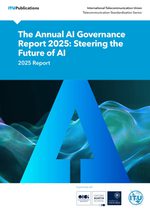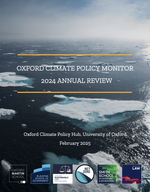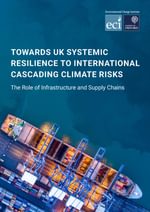At least half of global GDP is moderately or highly directly dependent on nature, and ultimately there is no economy without its critical services, including clean and abundant water, clean air and food. Nature across most of the globe has now been significantly altered by multiple human drivers, such as land-use change, pollution, extraction of minerals, abstraction of water and climate change. Statistics on the current state of biodiversity loss and environmental degradation are alarming: the extent and condition of ecosystems has declined in 50% of natural ecosystems, including more than 85% of wetland area lost, and 25% of species are at risk of extinction (IPBES, 2019). The 2019 Global Assessment Report of the Intergovernmental Science-Policy Platform on Biodiversity and Ecosystem Services (IPBES) concluded that fourteen of the eighteen ecosystem services that were assessed had declined since the 1970s. The United Kingdom is no exception. The percentage of UK habitats ‘in favourable or improving conservation status’ has been deteriorating since 2007, exacerbating impacts on our soils, pollinators, air and environmental pollution, water and flood protection. Our analyses show that 75% of the United Kingdom is covered by at least one hotspot of natural capital depletion, and 25% is covered by two or more hotspots of natural capital depletion. The UK, with its globally interconnected economy, is also exposed to significant global emerging risks.
The erosion of UK and global natural capital generates significant and long-term risks to society and the UK economy and financial sector. Studies by Central Banks around the world have highlighted the high degree of dependence on nature and the exposure of financial portfolios to nature-related risks. What is not yet clear, is the extent to which this is a material risk to financial stability, on a par with other risks on the radar of Central Banks, and if so, on what timescales this risk could emerge and where it might ‘fall through the cracks’ of current supervision and regulation.
The objective of this project was to assess the materiality of nature-related risks to the UK financial sector both in the near-term and the longer-term. To address this, we develop six innovations:
- 1. The first Nature-Related Risk Inventory for the UK (UK-NRRI), equivalent in format to the National Risk Register or Climate Change Risk Assessment (CCRA).
- 2. Dependency analysis with spatial information to track dependencies on international supply and the nature risks therein, alongside transition risk exposures for the seven largest banks.
- 3. Development of sector-specific nature-related Value at Risk (nVaR) scores.
- 4. Co-development of three benchmark scenarios of nature-related risks, following the approach outlined by the Taskforce on Nature-Related Financial Disclosures (TNFD 2023).
- 5. Macroeconomic modelling to gauge the potential impacts on UK prosperity and resilience.
- 6. Preliminary financial ‘stress test’ for the domestic lending of the UK’s seven largest banks.
The analyses focus on physical nature-related risks, with exposure analysis or transition risks.
The findings demonstrate that biodiversity loss and environmental degradation create material risks for the UK economy and financial sector, in addition to their wider social and biodiversity impacts. These impacts are near and present. We find that the deterioration of our natural environment could slow economic growth and result in UK Gross Domestic Product (GDP) being 6% lower than it would have been otherwise by the 2030s under two scenarios (domestic and international) and 12% lower under an AMR-pandemic scenario. These are greater than the impact on GDP experienced in the Global Financial Crisis, in which UK GDP fell by around 4% to 6%, and - for the AMR-pandemic scenario – greater than the GDP impact of the COVID-19 pandemic when GDP fell 11% over 2020. While these findings are preliminary, all the evidence points to them being conservative. This study focussed on quantifying near- to medium-term risks, but the evidence clearly demonstrates these risks will increase over time with the potential for crossing tipping points.
The compounding impacts of climate and nature loss would have a very material impact on UK GDP; equivalent to several lost years of growth. It is not realistic to consider nature in isolation as climate change and environmental degradation are occurring in parallel and are interconnected. Environmental degradation increases the likelihood and severity of an acute climate or health shock, and the combined effect would have a very material impact on the economy. For this reason, we also draw upon the NGFS climate scenarios to explore the compounding impacts of climate and nature. We find that in our acute shock scenarios, these compounding impacts can lead to a UK GDP that is 8% lower than it would be otherwise, with a peak shock that wipes out around £200 billion from UK GDP and persists for several quarters, equivalent to 4 – 7 years of lost growth over the period.
The gradual impacts of environmental degradation on the economy are as detrimental or more so than climate change in the near-term - and the chronic year-to-year changes lead to losses that are as important as more sudden shocks. We find that the impact to GDP of chronic year-on-year environmental degradation is at least on par with that from physical climate change risks in the coming decade and for acute shocks, can be far greater than climate impacts alone. In effect, the impacts of environmental degradation are doubling or more the impact of climate change. Antimicrobial resistance (AMR) and zoonotic diseases are closely linked with deforestation and habitat destruction which can bring humans and wild animals into closer contact and have been shown to lead to greater abundance of antibiotic resistance genes in soil. Chronic nature-related risks associated with soil degradation, water provisioning, pollution and pollination services have material impacts on agriculture, manufacturing, construction, utilities and key supply chains.
Around half of UK nature-related risks come from overseas, through supply chains and financial exposures, pointing toward the importance of working internationally to close the gaps in disclosures and risk management. The four trillion GBP of financial assets assessed are dependent upon many trillions more of assets globally. Analyses of UK financial exposures suggest that 56% of the total upstream f inancial exposures have a High or Very High dependence on ecosystem services. Exposures to overseas risks are most material (in financial terms) for the services and manufacturing sectors, with highest risks related to water.
The agricultural sector is most at risk in percentage terms, but the largest risks in monetary terms are to the services and manufacturing sectors. Agriculture can be impacted by disruption to several ecosystem services, with potential reductions in output (the nature-related value at risk – or nVaR) up to 15% of total annual production for disruption of any one service, albeit multiple ecosystem services at risk and impacts occur simultaneously, with risks to related to pollination services, soil quality and invasive species. Looking across the UK economy, we find that the nVaR associated with disruption to ecosystem services is in the hundreds of billions and equivalent to several percentage points of GDP; water risks alone are equivalent to around 13% UK GDP (for an extreme 1-in-100 year risk). The agricultural sector is also the most exposed to transition risks and opportunities.
Looking across the portfolios of the seven largest UK banks, the analyses indicate possible adjustments in the valuations of domestic holdings (excluding finance) of up to 4 – 5% over the coming decade from physical nature-related risks. Depending on the bank, the most at-risk sectors include agriculture, utilities, real-estate and manufacturing. Preliminary analyses suggest that between 8% and 53% of the portfolios of the seven largest banks are exposed also to transition risks. Firms could also derive opportunities from the nature-positive transition; including new demand for nature-positive products and services.
The findings of this study take us further than previous studies to-date by clearly demonstrating the materiality of nature-related risks and the potential for compounding risks with climate change. Further work is needed to assess the implications for regulation, policy and supervision. 7FULL REPORT: Assessing the Materiality of Nature-Related Financial Risks for the UK Based upon the findings presented here and elsewhere, we believe there is a case for action by Central Banks, regulators and governments to assess if and where nature may be falling through the cracks of current frameworks and where this could lead to financial stability risks that justify explicit changes to those frameworks. We make a series of arguments based on the evidence for why nature may present new challenges that necessitate action. It is clear, for example, from other work (e.g. GARP 2024 and TNFD 2023), that there are sizeable information asymmetries created by the lack of disclosures of nature-related risks and impacts that mean that risks are currently under-priced. This may lead to an accumulation of systemic risk that goes undetected. We also lay out how nature-related risks suffer from the same ‘tragedy of the horizon’ issue identified by Mark Carney in 2015, but also additional challenges of a ‘tragedy of scale’ and unique drivers and risk transmission channels that are not captured within current climate-related risk assessments.
This study adds further evidence to support the conclusion from the Dasgupta Review and others that an early orderly transition toward a nature-positive economy brings significant benefits for UK prosperity and financial stability, through reducing both transition and physical risks, as well as for people and planet. Actions that could be considered by regulators and supervisors to mitigate risks to financial stability include advancing disclosures, broadening supervisory statements on climate to explicitly include environmental risks and introducing a simple nature-risk scenario within exploratory scenario exercises. There are many low-regrets measures that could be taken now, including supporting capability building through for a such as the Climate Financial Risk Forum and working with the scientific community to advance a set of benchmark scenarios, building upon those developed here. Regulators should also take timely opportunities to incorporate nature alongside climate into emerging frameworks, for example on transition plans, ISSB standards and taxonomies.
For financial institutions, the findings should motivate action to assess and manage nature-related financial risks, build capability, and begin to incorporate nature into emerging transition plans. These preliminary results suggest that even in the short-term nature-related risk is not negligible, especially if the losses are considered in relative terms to specific fractions of a lending portfolio. Financial institutions can manage risks to their own portfolios through working with their clients to reduce risks through supporting their transition and resilience. Importantly the transition toward a nature-positive economy presents opportunities as well as risks. With early action, UK firms – both financial and real-economy – can capture these opportunities.
For government, the materiality of nature-related risks demonstrated in this study add additional urgency to put in place the mechanisms, domestically and globally, to meet the goals and targets of the Kunming-Montreal Global Biodiversity Framework (GBF), as well as domestic policies such as the Environmental Improvement Plan (2023). This includes engaging internationally to ensure that emerging sustainable finance frameworks incorporate nature and nature related, including the IFRS Foundation’s ISSB. There is also an urgent rationale for investment and closer working with the scientific community to improve data and analytics as a public good to underpin the UK's transition to a resilient, nature-positive economy.
To continue to advance this area, strengthening collaboration between financial institutions and the scientific community is essential. Nature-related financial risk assessment is in its infancy, but risks are significant. This study has revealed several gaps in knowledge and approaches that require further study. It has also produced a series of tools that can be advanced today:
- A Nature-Related Risk Inventory (UK-NRRI) that includes 29 key risks to the UK, with zoonotic diseases and antimicrobial resistance, soil health decline and global repercussions of food insecurity emerging as highest risks in terms of likelihood and impacts.
- A set of benchmark narrative and quantitative scenarios that could form the basis for the further codevelopment of a set of scenarios for financial institutions, through fora such as the Climate Financial Risk Forum and UK Integrating Finance and Biodiversity network.
There is a need to build platforms for collaboration and an opportunity to build upon existing fora such as the Climate Financial Risk Forum. The new £7m UKRI Integrating Finance and Biodiversity network, bringing together 17 research institutions, provides a ready venue to deepen collaborations.
Finally, while our focus has been on nature-related risks, the findings have implications for climate change given the strong interconnections between climate and nature The findings suggest that incorporating nature-related risk amplifications in climate scenarios would double the estimated impact of climate change on the UK economy, beyond what is currently predicted by the NGFS.





